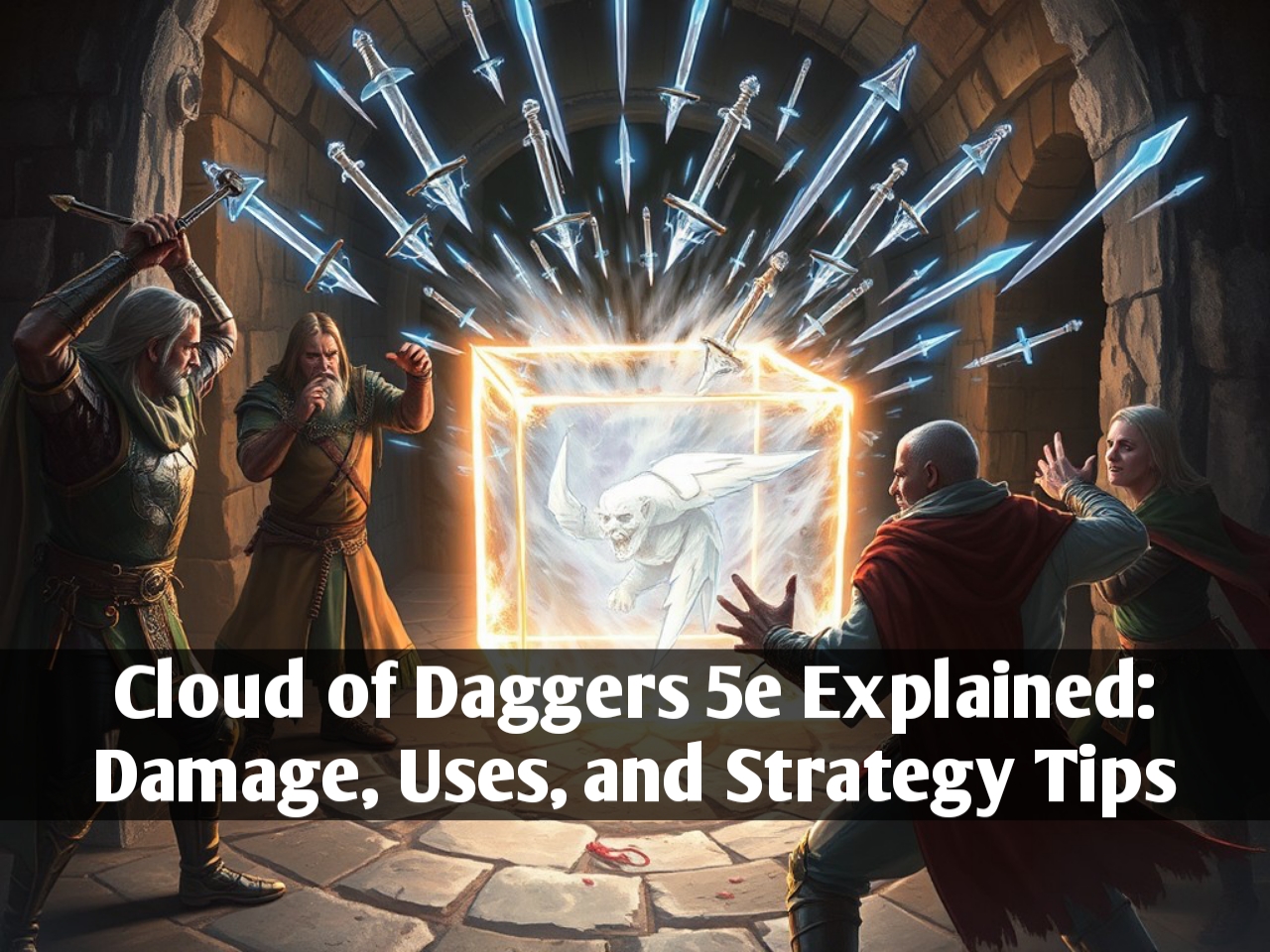Cloud of Daggers 5e Explained: Damage, Uses, and Strategy Tips
In Dungeons & Dragons 5th Edition (D&D 5e), spells play an integral role in shaping how characters engage in combat, solve problems, and explore the world. Among the vast array of spells, Cloud of Daggers is one of the more unique and potent options for spellcasters. Its simple mechanics and significant area-of-effect damage make it a versatile tool for both offensive and defensive strategies. In this article, we’ll take an in-depth look at the Cloud of Daggers spell, breaking down its damage potential, best uses in combat, and strategies for maximizing its effectiveness.
What is Cloud of Daggers 5e?
At its core, Cloud of Daggers is a 2nd-level conjuration spell available to spellcasters like Bards, Sorcerers, and Wizards. The spell conjures a swirling mass of magical daggers that fill a specific area, dealing damage to creatures that enter or remain within that space. It’s a spell that can easily turn the tide of battle by controlling enemy movement and dealing consistent, unavoidable damage.
The core features of Cloud of Daggers are as follows:
- Casting Time: 1 action
- Range: 60 feet
- Components: Verbal, Somatic, Material (a sliver of glass)
- Duration: Concentration, up to 1 minute
When cast, Cloud of Daggers creates a 5-foot cube filled with spinning blades, making it a deadly trap for any creature within that area. The spell’s damage starts at 4d4 slashing damage and increases if you use higher-level spell slots to cast it.
Cloud of Daggers Mechanics: Understanding the Basics
To fully leverage Cloud of Daggers, it’s crucial to understand its core mechanics. As a 5-foot cube, the area affected by the spell is relatively small, meaning it only covers a single square on a standard D&D battle map. However, the spell’s power lies in its ability to consistently deal damage to any creature that enters or starts its turn within the affected space.
- Damage Calculation: On the first round that a creature enters or starts its turn within the spell’s area, it takes 4d4 slashing damage. This damage is automatic; no saving throw is allowed. While 4d4 may not seem like a massive amount of damage at first, the fact that the spell persists over time and deals consistent damage on every turn makes it incredibly dangerous, especially in confined spaces or when combined with other control effects.
- Concentration Requirement: Like many powerful spells, Cloud of Daggers requires concentration, meaning the caster must maintain focus on the spell while it’s active. If the caster takes damage, they must make a concentration check (a Constitution saving throw) to maintain the spell.
- Scaling with Spell Slots: One of the key strengths of Cloud of Daggers is its ability to scale with the use of higher-level spell slots. For every spell slot above 2nd level, the spell deals an additional 2d4 damage. This makes it a flexible option as spellcasters gain more powerful spell slots.
When and How to Use Cloud of Daggers in Combat
While Cloud of Daggers has straightforward mechanics, using it effectively requires strategic thinking. It’s a spell that excels in controlling the battlefield, and its strength lies in its ability to restrict enemy movement or force them to take damage by staying in or passing through the area of effect. Here are several key scenarios where Cloud of Daggers shines:
1. Choke Points and Narrow Spaces
One of the best uses of Cloud of Daggers is to place it in choke points or narrow passages. Since the spell covers a small 5-foot cube, placing it in a narrow hallway, doorway, or other confined space can severely limit enemy movement. Creatures that are forced to move through the area will take damage, and if they’re trapped in the area, they will take damage at the start of their turn as well.
By placing Cloud of Daggers in these tight spaces, you create a tactical advantage for your party, making it difficult for enemies to maneuver without suffering heavy damage.
2. Combining with Control Spells
Cloud of Daggers works exceptionally well when combined with spells or abilities that control enemy movement. Spells like Hold Person, Entangle, or Web can trap enemies in place, forcing them to take the damage from Cloud of Daggers each round. Similarly, grappling or shoving enemies into the cloud can be a devastating combination, allowing you to maximize the damage output.
For example, if an enemy is restrained by Entangle and you cast Cloud of Daggers on their space, they will take 4d4 slashing damage at the start of every turn, unable to move out of the area to escape the damage.
3. Targeting Key Enemies
If the battlefield allows it, you can use Cloud of Daggers to focus on a particularly dangerous enemy, like a spellcaster or boss monster. By casting the spell on or near them, you force them into a difficult decision: either move out of the area and potentially give up a favorable position or remain within the cloud and take significant damage.
Since there is no saving throw for Cloud of Daggers, even highly evasive or high-AC enemies will take damage, making it an excellent choice for whittling down dangerous foes over time.
Strategic Considerations for Cloud of Daggers
While Cloud of Daggers is a powerful spell, it requires some thought to use it effectively. To get the most out of the spell, you should consider the following strategic elements:
1. Positioning and Battlefield Awareness
The small area of Cloud of Daggers means that positioning is key. Before casting the spell, think carefully about where enemies are likely to move and where the spell will have the most impact. Placing the spell in an empty square may not be effective unless you can control enemy movement or anticipate where they’ll go. Try to aim for areas where enemies are likely to pass through or become trapped, such as in front of an advancing enemy group or in a retreat path.
2. Concentration Management
Since Cloud of Daggers requires concentration, the caster needs to be aware of potential sources of damage that could break their concentration. Casters should avoid the front lines of combat and take precautions to minimize the risk of losing concentration, such as using the Shield spell or taking cover behind allies. Additionally, remember that you can only concentrate on one spell at a time, so if you have other concentration-based spells in play (like Hold Person or Invisibility), you’ll need to decide which spell provides more value at the moment.
3. Resource Management
While Cloud of Daggers is available at the 2nd-level spell slot, it’s also possible to cast it using higher-level spell slots for increased damage. However, it’s important to weigh the benefits of boosting Cloud of Daggers against the opportunity cost of using higher-level slots. For example, using a 4th-level spell slot for Cloud of Daggers increases the damage to 8d4 per turn, but it also prevents you from casting higher-level spells like Polymorph or Fireball.
4. Duration of Combat
Because Cloud of Daggers lasts for up to a minute, it can deal damage over multiple turns, potentially contributing more damage overall than a single large-damage spell like Fireball. However, this requires the combat to last several rounds, so consider the likelihood of a prolonged fight when deciding whether to use Cloud of Daggers.
Pros and Cons of Cloud of Daggers in D&D 5e
Like any spell, Cloud of Daggers has both strengths and weaknesses. Let’s break down some of the pros and cons to help determine when this spell is the right choice for your character.
Pros:
- Consistent, Unavoidable Damage: One of the biggest advantages of Cloud of Daggers is that it deals damage automatically, with no saving throw. This makes it reliable, especially against high-AC or evasive enemies.
- Area Control: By placing Cloud of Daggers in strategic locations, you can limit enemy movement and force them to make difficult choices.
- Scaling Damage: The ability to scale damage with higher-level spell slots makes Cloud of Daggers relevant even as characters gain higher levels and face more powerful enemies.
Cons:
- Small Area of Effect: The 5-foot cube affected by the spell is quite small, limiting the number of enemies you can hit with it at once. It’s not ideal for large groups of enemies spread out across the battlefield.
- Requires Concentration: Since the spell requires concentration, the caster can’t maintain other concentration-based spells while Cloud of Daggers is active. Additionally, the caster risks losing the spell if they take damage and fail a concentration check.
- Limited Mobility Impact: While Cloud of Daggers can control an area, it doesn’t prevent creatures from leaving the area or moving freely afterward. Unlike spells like Wall of Fire or Spike Growth, it doesn’t impose movement penalties or lasting terrain effects.
Class Synergy: Best Classes for Cloud of Daggers
Certain classes and subclasses in D&D 5e can make particularly good use of Cloud of Daggers, either due to their spellcasting abilities or their ability to synergize with control spells. Here are some of the best options:
1. Bard (College of Lore)
Bards, especially those in the College of Lore, can excel with Cloud of Daggers due to their ability to focus on crowd control and support. With the added spells from Magical Secrets, they can easily create synergies by casting Cloud of Daggers alongside other control effects.
2. Wizard (School of Conjuration)
Wizards from the School of Conjuration benefit from the ability to conjure a wide variety of effects, and Cloud of Daggers fits naturally into their arsenal. The conjuration subclass allows for greater control over summoned effects, and wizards generally have a wide array of battlefield control spells to complement Cloud of Daggers.
3. Sorcerer (Draconic Bloodline)
Sorcerers, particularly those with the Draconic Bloodline, can use Cloud of Daggers to great effect, especially when empowered by their Metamagic abilities. For instance, using the Extend Spell Metamagic can prolong the duration of Cloud of Daggers, increasing its overall damage potential.
Conclusion: Is Cloud of Daggers Worth It?
Cloud of Daggers may not have the flashiness of a Fireball or the crowd-control power of Hold Person, but it remains a solid and versatile spell for controlling the battlefield and dealing consistent damage. Its reliability, lack of a saving throw, and scaling damage make it a valuable tool for spellcasters who want to control enemy movement or force them into tough decisions.
By using Cloud of Daggers in conjunction with other control effects, positioning it in strategic locations, and understanding how to protect your concentration, you can make the most out of this seemingly simple but deadly spell in D&D 5e. Whether you’re locking down a choke point or focusing fire on a high-value target, Cloud of Daggers can be a game-changer in the right hands.
Read Also Our This Post: Step-by-Step Guide: How to Make Cloud in Little Alchemy 2

Kamran Khatri is a versatile writer and editor at ExpressZone.co.uk, bringing fresh perspectives and insightful commentary across a wide range of topics. With a passion for exploring diverse subjects—from technology, business, and finance to lifestyle, travel, and the arts—Kamran aims to inform, inspire, and engage readers through well-researched articles and thought-provoking content.
His work spans multiple categories including health, education, pets, entertainment, real estate, and sustainability, reflecting his commitment to delivering knowledge that connects with everyday life. Whether breaking down the latest trends, sharing practical tips, or highlighting cultural insights, Kamran’s writing combines clarity with creativity.
When he’s not crafting stories for ExpressZone.co.uk, Kamran enjoys keeping up with global developments, exploring innovative ideas, and connecting with readers who share his curiosity about the world.







